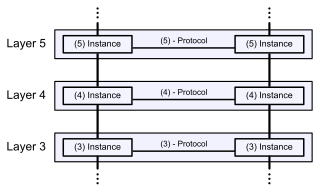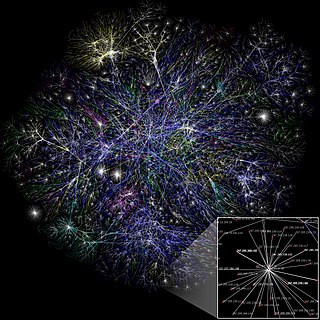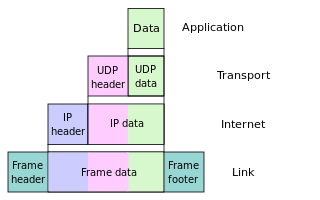Related Research Articles
The Internet protocol suite, commonly known as TCP/IP, is a framework for organizing the set of communication protocols used in the Internet and similar computer networks according to functional criteria. The foundational protocols in the suite are the Transmission Control Protocol (TCP), the User Datagram Protocol (UDP), and the Internet Protocol (IP). Early versions of this networking model were known as the Department of Defense (DoD) model because the research and development were funded by the United States Department of Defense through DARPA.

The Open Systems Interconnection (OSI) model is a reference model from the International Organization for Standardization (ISO) that "provides a common basis for the coordination of standards development for the purpose of systems interconnection." In the OSI reference model, the communications between systems are split into seven different abstraction layers: Physical, Data Link, Network, Transport, Session, Presentation, and Application.
Steganography is the practice of representing information within another message or physical object, in such a manner that the presence of the information is not evident to human inspection. In computing/electronic contexts, a computer file, message, image, or video is concealed within another file, message, image, or video. The word steganography comes from Greek steganographia, which combines the words steganós, meaning "covered or concealed", and -graphia meaning "writing".
In telecommunications and computer networking, a network packet is a formatted unit of data carried by a packet-switched network. A packet consists of control information and user data; the latter is also known as the payload. Control information provides data for delivering the payload. Typically, control information is found in packet headers and trailers.

Network address translation (NAT) is a method of mapping an IP address space into another by modifying network address information in the IP header of packets while they are in transit across a traffic routing device. The technique was originally used to bypass the need to assign a new address to every host when a network was moved, or when the upstream Internet service provider was replaced, but could not route the network's address space. It has become a popular and essential tool in conserving global address space in the face of IPv4 address exhaustion. One Internet-routable IP address of a NAT gateway can be used for an entire private network.

In computer networking, the transport layer is a conceptual division of methods in the layered architecture of protocols in the network stack in the Internet protocol suite and the OSI model. The protocols of this layer provide end-to-end communication services for applications. It provides services such as connection-oriented communication, reliability, flow control, and multiplexing.
A virtual private network (VPN) is a mechanism for creating a secure connection between a computing device and a computer network, or between two networks, using an insecure communication medium such as the public Internet.
The data link layer, or layer 2, is the second layer of the seven-layer OSI model of computer networking. This layer is the protocol layer that transfers data between nodes on a network segment across the physical layer. The data link layer provides the functional and procedural means to transfer data between network entities and may also provide the means to detect and possibly correct errors that can occur in the physical layer.
An application layer is an abstraction layer that specifies the shared communication protocols and interface methods used by hosts in a communications network. An application layer abstraction is specified in both the Internet Protocol Suite (TCP/IP) and the OSI model. Although both models use the same term for their respective highest-level layer, the detailed definitions and purposes are different.
IPX/SPX stands for Internetwork Packet Exchange/Sequenced Packet Exchange. IPX and SPX are networking protocols used initially on networks using the Novell NetWare operating systems. They also became widely used on networks deploying Microsoft Windows LANS, as they replaced NetWare LANS, but are no longer widely used. IPX/SPX was also widely used prior to and up to Windows XP, which supported the protocols, while later Windows versions do not, and TCP/IP took over for networking.
Internet security is a branch of computer security. It encompasses the Internet, browser security, web site security, and network security as it applies to other applications or operating systems as a whole. Its objective is to establish rules and measures to use against attacks over the Internet. The Internet is an inherently insecure channel for information exchange, with high risk of intrusion or fraud, such as phishing, online viruses, trojans, ransomware and worms.
In computer networks, a tunneling protocol is a communication protocol which allows for the movement of data from one network to another. It can, for example, allow private network communications to be sent across a public network, or for one network protocol to be carried over an incompatible network, through a process called encapsulation.
Secure communication is when two entities are communicating and do not want a third party to listen in. For this to be the case, the entities need to communicate in a way that is unsusceptible to eavesdropping or interception. Secure communication includes means by which people can share information with varying degrees of certainty that third parties cannot intercept what is said. Other than spoken face-to-face communication with no possible eavesdropper, it is probable that no communication is guaranteed to be secure in this sense, although practical obstacles such as legislation, resources, technical issues, and the sheer volume of communication serve to limit surveillance.

A computer network is a set of computers sharing resources located on or provided by network nodes. Computers use common communication protocols over digital interconnections to communicate with each other. These interconnections are made up of telecommunication network technologies based on physically wired, optical, and wireless radio-frequency methods that may be arranged in a variety of network topologies.

Encapsulation is the computer-networking process of concatenating layer-specific headers or trailers with a service data unit for transmitting information over computer networks. Deencapsulation is the reverse computer-networking process for receiving information; it removes from the protocol data unit (PDU) a previously concatenated header or tailer that an underlying communications layer transmitted.

A storage area network (SAN) or storage network is a computer network which provides access to consolidated, block-level data storage. SANs are primarily used to access data storage devices, such as disk arrays and tape libraries from servers so that the devices appear to the operating system as direct-attached storage. A SAN typically is a dedicated network of storage devices not accessible through the local area network (LAN).
A communication protocol is a system of rules that allows two or more entities of a communications system to transmit information via any variation of a physical quantity. The protocol defines the rules, syntax, semantics, and synchronization of communication and possible error recovery methods. Protocols may be implemented by hardware, software, or a combination of both.
The link layer is the lowest layer in the TCP/IP model. It is also referred to as the network interface layer and mostly equivalent to the data link layer plus physical layer in OSI. This particular layer has several unique security vulnerabilities that can be exploited by a determined adversary.
References
- ↑ Butler Lampson (1 October 1973). "A note on the confinement problem". Communications of the ACM . 16 (10): 613–615. doi:10.1145/362375.362389. ISSN 0001-0782. Wikidata Q56446421.
- 1 2 Computer Security Technology Planning Study (James P. Anderson, 1972)
- ↑ NCSC-TG-030, Covert Channel Analysis of Trusted Systems (Light Pink Book), 1993 from the United States Department of Defense (DoD) Rainbow Series publications.
- ↑ 5200.28-STD, Trusted Computer System Evaluation Criteria (Orange Book), 1985 Archived 2006-10-02 at the Wayback Machine from the DoD Rainbow Series publications.
- ↑ GIRLING, GRAY (February 1987). "Covert Channels in LAN's". IEEE Transactions on Software Engineering. SE-13 (2): 292–296. doi:10.1109/tse.1987.233153. S2CID 3042941. ProQuest 195596753.
- ↑ Hiding data in the OSI network model Archived 2014-10-18 at the Wayback Machine , Theodore G. Handel and Maxwell T. Sandford II (2005)
- ↑ Covert Channels in the TCP/IP Protocol Suite Archived 2012-10-23 at the Wayback Machine , 1996 Paper by Craig Rowland on covert channels in the TCP/IP protocol with proof of concept code.
- ↑ Zander, S.; Armitage, G.; Branch, P. (2007). "A survey of covert channels and countermeasures in computer network protocols". IEEE Communications Surveys and Tutorials. 9 (3). IEEE: 44–57. doi:10.1109/comst.2007.4317620. hdl: 1959.3/40808 . ISSN 1553-877X. S2CID 15247126.
- ↑ Information hiding in communication networks : fundamentals, mechanisms, applications, and countermeasures. Mazurczyk, Wojciech., Wendzel, Steffen., Zander, Sebastian., Houmansadr, Amir., Szczypiorski, Krzysztof. Hoboken, N.J.: Wiley. 2016. ISBN 9781118861691. OCLC 940438314.
{{cite book}}: CS1 maint: others (link) - ↑ Wendzel, Steffen; Zander, Sebastian; Fechner, Bernhard; Herdin, Christian (April 2015). "Pattern-Based Survey and Categorization of Network Covert Channel Techniques". ACM Computing Surveys. 47 (3): 50:1–50:26. arXiv: 1406.2901 . doi:10.1145/2684195. ISSN 0360-0300. S2CID 14654993.
- ↑ Cabuk, Serdar; Brodley, Carla E.; Shields, Clay (April 2009). "IP Covert Channel Detection". ACM Transactions on Information and System Security. 12 (4): 22:1–22:29. CiteSeerX 10.1.1.320.8776 . doi:10.1145/1513601.1513604. ISSN 1094-9224. S2CID 2462010.